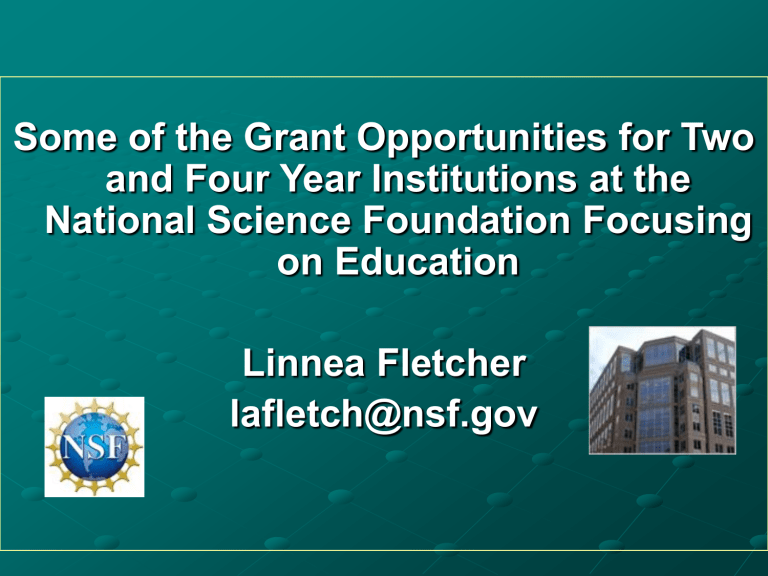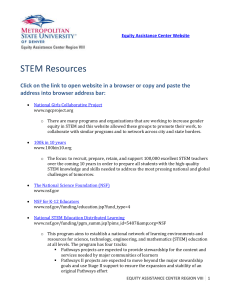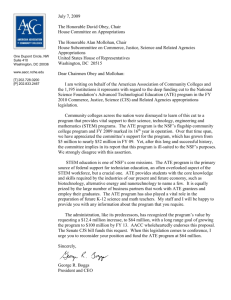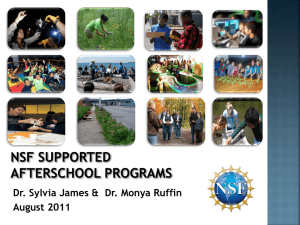Math and Science Partnership

Some of the Grant Opportunities for Two and Four Year Institutions at the
National Science Foundation Focusing on Education
Linnea Fletcher lafletch@nsf.gov
Caution
Most of the information presented in this workshop represents the opinions of the individual program officers and not an official NSF position.
The Obvious Choices are in EHR
Office of the
Assistant Director (OAD)
Division of Graduate Education
(DGE)
Division of Research on Learning in Formal and Informal Settings
(DRL)
Division of Human
Resource Development (HRD)
Division of Undergraduate
Education (DUE)
NSF EHR Budget
Education and Human Resources (EHR):
FY 2009 (Requested) $709 Million
Division of Undergraduate Education (DUE):
FY 2007 (Actual)
FY 2008 (Estimate)
FY 2009 (Requested)
$204.96 Million
$211.05 Million
$219.83 Million
*Note: Extra $75 million from H-1B visa fees employers pay to obtain a visa for a foreign high-tech worker to fund the S-STEM program.
NSF Budget
Stimulus Plan 2009 for DUE
- NOYCE Scholarship Program: 60 M
- Math and Science Partnership
(MSP) Program: 25 M
DUE Programs
Workforce Development
Advanced Technological Education (ATE)
STEM Talent Expansion Program (STEP)
ATE
ATE is in its 16 th year of funding community colleges, having started with the Science and Advanced Technology Act of 1992 (SATA).
FY2008
Preliminary Proposals April 23, 2009
Formal Proposals Oct. 15, 2009
Check into the FaST Program: Partnership with DoE
ATE Tracks
3 Tracks
1. Projects including small projects
2. Centers
3. Targeted Educational Research
Projects
www.ateprojectimpact.org
Projects can focus on one or more aspects of:
Program Improvement;
Professional Development for Educators;
Curriculum and Educational Materials Development;
Teacher Preparation
(http://www.aacc.nche.edu/Resources/aaccprograms/ate/Docu ments/teacherprep_stem.pdf)
Research on Technician Education; or
Institution-Level Reform of Technician Education
Small Grants for Institutions New to ATE
Purpose
Simulates implementation, adaptation, and innovation in all areas supported by ATE.
Available only to community college campuses that have not an an ATE award within the last 10 years
Broaden the base of participation of community colleges in ATE.
Strengthen the role of community colleges in meeting needs of business and industry
Proposers are encouraged to include resources of ATE and other NSF awardees and to include those people as consultants and subawardees.
Limited to $150,000 with a maximum of 10% indirect
Centers of Excellence – National,
Regional, Resource http://www.ATECenters.org
ATE Centers of Excellence (36)
1
National Center
Regional Center
Resource Center
AK
HI
AgKnowledge,
A National Partnership
Kirkwood Community College
P.I.: Terry A. Brase
DUE 0434405 & 0757239
ATE Center
Building partnerships nationwide among community colleges, four-year institutions, and business and industry to improve agricultural technology education in the U. S.
Improving the mathematics, science, and technical competencies in an integrated way for agriculture technology graduates
Assuring that graduates are well prepared for an increasingly technological workforce
Focusing on curriculum development, faculty development, recruitment of students, and capacity building
Expanded ATE Opportunity Track 3:
Targeted Research in Technician Education
Supports research on technician education, employment trends, changing role of technicians in the workplace, and other topics that make technician programs more effective and forward looking.
Represents a TRUE collaboration reflected in activities, leadership, and budget between well-qualified researchers and two-year college educators and others as appropriate.
STEP
Goal: to increase the number of students
(U.S. citizens or permanent residents)
RECEIVING associate or baccalaureate degrees in established or emerging fields within science, technology, engineering, and mathematics (STEM)
STEP Tracks
Type 1: Implement strategies that will increase the number of students obtaining STEM degrees.
Type 2: Conduct research on factors affecting associate or baccalaureate degree attainment in STEM
17
STEP
Letter of Intent: August 18, 2009
August 17, 2010
Proposal Due Date:
September 29, 2009
September 28, 2010
DUE Programs
Workforce Development – Scholarship
Programs
Federal Cyber Service: Scholarships for
Service (SFS)
NSF Scholarships in Science, Technology,
Engineering, and Mathematics (S-STEM)
Robert Noyce Scholarship Program (Noyce)
Federal Cyber Service:
Scholarships for Service (SFS)
Victor P Piotrowski vpiotrow@nsf.gov
Stephen C Cooper sccooper@nsf.gov
The Federal Cyber Service: Scholarship for Service (SFS) program seeks to increase the number of qualified students entering the fields of information assurance and computer security and to increase the capacity of the United States higher education enterprise to continue to produce professionals in these fields to meet the needs of our increasingly technological society. The SFS program is composed of two tracks, scholarship and capacity building.
Solicitation Date: December?
S-STEM
Goal: Provides institutions funds to provide scholarships to academically talented, but financial needy, students.
Students can be pursuing associate, baccalaureate, or graduate degrees.
Letter of Intent: July ?, 2009
Full Proposal: August ?, 2009
S-STEM
-
Eligible disciplines extended to include biology, physical and mathematical sciences, computer and information sciences, geosciences, and engineering
Maximum scholarships $10,000
(based on financial need)
Grant size: up to $600,000
One proposal per constituent school or college
About $50-$70 million available
22
S-STEM
Special Program Features
Has a faculty member in a STEM discipline as the PI.
Involves cohorts of students.
Provides student support structures.
Includes optional enhancements such as research opportunities, tutoring, internships, etc.
Enrolls students full time.
23
Noyce Program
Initiated by Act of Congress in 2002
Reauthorized in 2007 (America
COMPETES Act)
To encourage talented mathematics, science, and engineering undergraduates to pursue teaching careers
To encourage STEM professionals to become teachers
To prepare Master Teachers
Noyce Program
Robert Noyce Teacher Scholarship Track
Scholarships for undergraduate STEM majors preparing to become K12 Teachers
Internships for freshmen and sophomores
Stipends for STEM professionals seeking to become K12 teachers
Noyce Program Eligibility
Proposals may only be submitted by:
Universities & 2- or 4-year colleges
Nonprofit entities that have established consortia among such IHEs
Principal Investigators:
The PI, or at least one Co-PI, must be a faculty member in a STEM department.
Math and Science Teachers Project:
Teachers of Excellence Program
Lake City Community College PI: Tracy Hickman
Alternative certification program for STEM professionals in rural North Central Florida
Practical experience with lesson planning, classroom management, and research-based cooperative learning strategies
Integration of real world math and science into classroom
Cohort development, mentoring, and follow-up supervision
St. Edward’s University Robert Noyce
Scholarship Program
St. Edward’s University PI: Karen Jenlink
Partnership with Austin Community College
Recruiting STEM majors to teach in grades 4 -12 in
Austin School District
Cohort-based professional development focused on strategies for successful science and math teaching in high need school districts
Summer Science Leadership Academy for Noyce
Scholars
Early field experiences for freshmen and sophomores in summer environmental campInduction program
More DUE Programs
Curriculum, Laboratory, and Instructional
Development
Course, Curriculum and Laboratory
Improvement (CCLI) New Solicitation!
National STEM Education Digital Library
(NSDL)
Math Science Partnership (MSP)
CCLI
Vision
Excellent STEM education for all undergraduate students.
Goal
Stimulate, disseminate, and institutionalize transformative or innovative developments in
STEM education through the production of knowledge and the improvement of practice .
*Most comprehensive program
Type 1 Projects
70 to 75 awards expected
Total budget up to $200,000 for 2 to 3 years
250,000 when 4-year and 2-year schools collaborate
Deadline
May 21, 2009 (A-M states)
May 22, 2009 (N-Z states)
Type 2 Projects
20 to 25 awards expected
Total budget up to $600,000 for 2 to 4 years.
Deadline January 13, 2010
Type 3 Projects
3 to 5 awards expected
Budget negotiable, but not to exceed
$5,000,000 over 5 years.
Deadline January 13, 2010
CCLI Central Resource Projects
1 to 3 awards expected
Budget negotiable, depending on the scope and scale of the activity
Small focused workshop projects -- 1 to 2 years & up to $100,000
Large scale projects -- 3 to 5 years &
$300,000 to $3,000,000
Deadline January 13, 2010
National STEM Education
Distributed Learning (NSDL)
This program aims to establish a national network of learning environments and resources for science, technology, engineering, and mathematics (STEM) education at all levels. The program has four tracks. Reference to NSDL can be found in other solicitations, like CCLI.
Full proposal: April 15, 2009
Math and Science Partnership
Seeks to improve student outcomes in mathematics and science for all students, at all K-12 levels
Substantial intellectual engagement of mathematicians, scientists and engineers from higher education in improving K-
12 student outcomes in mathematics and the sciences
A coordinated effort between NSF and ED, who together have defined the program linkages necessary to manage investment for greatest effectiveness
MSP Key Features
• Partnership-driven, with significant engagement of faculty in mathematics, the sciences, and engineering
• Teacher quality, quantity, and diversity
• Challenging courses and curricula
• Evidence-based design and outcomes
• Institutional change and sustainability
MSP
Types of MSP Projects
Targeted Partnerships
Institute Partnerships
MSP-Start Partnerships
Phase II Partnerships
Research, Evaluation and Technical
Assistance (RETA)
MSP-Start Partnerships
Seeks to include institutions of higher education of varying scope, size, experience and perspectives emphasizing minority-serving institutions (e.g., Tribal
Colleges, Historically Black Colleges and
Universities, Hispanic Serving Institutions), community colleges and primarily undergraduate institutions.
Conduct the data collection, analysis, team building and evaluation necessary for developing a proposal for a full MSP Targeted or Institute Partnership.
Award size: $300,000, up to 2 yrs
Mountain Empire MATH PAYS Partnership
Mountain Empire Community College
PI: Chris Allgyer
Partnership with University of Virginia College at Wise (UVA-Wise), five contiguous rural Virginia school districts, the Virginia Department of
Education and Virginia's Gaining Early Awareness and GEAR UP
Goals:
to attract, prepare and support K-12 teachers of mathematics by providing high quality, research based, standards-based in-service professional development including the provision of leadership skills
to bridge the gap between K-12 and higher education mathematics courses
to increase the number of students that complete more mathematics courses in high school
Involves analysis of data to identify the needs that will be the focus of a targeted partnership
North Cascades and Olympic Science
Partnership
Western Washington University
PI: George Nelson
Targeted Partnership includes 4 community colleges and 26 rural school districts
Focus on science education in grades 3 –10
Curriculum showcases
Developing a preservice science course sequence for elementary teachers across all institutions
Teacher Leadership Academy
Preservice field experiences in Teacher Leaders’ classrooms
Recruitment through Scholarships, future teacher clubs, high school teaching academies
EVEN MORE DUE Programs
Computational Science Training for Undergraduates in the Mathematical Sciences (CSUMS)
Cooperative Activity with Department of Energy
Programs for Education and Human Resource
Development (Request for Supplement)
Interdisciplinary Training for Undergraduates in
Biological and Mathematical Sciences (UBM)
Nanotechnology Undergraduate Education (NUE) in
Engineering NSF
Director's Award for Distinguished Teaching
Scholars (DTS) Presidential Awards for
Excellence in Science, Mathematics and
Engineering Mentoring (PASEM)
Research Coordination Networks in Biological
Sciences (RCN)
Division of Human Resource
Development (
HRD
)
Two-fold Mission:
To increase the participation and advancement of underrepresented minorities and minority-serving institutions, women and girls, and persons with disabilities at every level of the science and engineering enterprise.
To serve as a focal point for NSF's agency-wide commitment to enhancing the quality and excellence of science, technology, engineering, and mathematics (STEM) education and research through broadening participation by underrepresented groups and institutions.
HRD Programs
Minorities and Minority Serving Institutions
Alliances for Broadening Participation in STEM
Graduate Education and the Professoriate Program (AGEP)
The Louis Stokes Alliance for Minority Participation Program
(LSAMP) and Bridge to the Doctorate (BD) Program
Centers for Research Excellence in Science and
Technology (CREST)
Historically Black Colleges and Universities
Undergraduate Programs (HBCU-UP)
Tribal Colleges and Universities Program (TCUP)
HRD Programs
Women and Girls
Research on Gender in Science and
Engineering (GSE)
ADVANCE: Increasing the participation and representation of women in academic science and engineering careers (ADVANCE)
Persons with Disabilities
Research in Disabilities Education (RDE)
Louis Stokes Alliance for Minority
Participation Program ( LSAMP )
Goal: To develop the strategies to increase the number of minority students who complete BA/BS degrees in
STEM.
Partnerships between institutions, government agencies and laboratories, industry, and professional organizations are required.
Activities: student enrichment skill development and academic enrichment mentoring curricular and instructional improvement direct student support
Tribal Colleges and Universities Program
(TCUP)
Goal: To enhance the quality of STEM instructional and outreach programs at TCUs.
Emphasis on the leveraged use of information technologies to address the digital divide
Activities include:
Implementation of comprehensive institutional approaches to strengthen STEM teaching and learning
Improve access to, retention within and graduation from STEM programs
Eligible institutions are Tribal Colleges and Universities, Alaskan
Native and Native Hawaiian Serving Institutions
Division of Research on
Learning ( DRL )
Core Programs
Discovery Research K-12 ( DRK-12 )
Information Technology Experiences for
Students and Teachers ( ITEST )
Research and Evaluation on Education in
Science and Engineering ( REESE )
Informal Science Education ( ISE )
Advanced Technological Education (ATE)
Innovative Technology
Experiences for Students and
Teachers Program (ITEST)
The Goals of ITEST are to develop, implement, study, and evaluate strategies that:
Build a general knowledge base on approaches that increase US capacity in the STEM
Workforce (including information and communication technology or ICT)
Encourage K-12 students to consider and prepare for careers in the STEM workforce
Equip teachers to encourage and prepare students to enter the STEM workforce
50
WHAT IS ITEST?
The STEM Workforce includes : technologists, scientists, engineers, and mathematicians
Targets K-12 students and teachers
Focuses on any STEM area, especially those that uses design and information and communications technologies
Funded by H-1B Visa revenues
51
ITEST PROGRAM
COMPONENTS
A. STRATEGY PROJECTS design, implement, and test theory and practice-based models for classroom, afterschool, summer, or year-round learning experiences
Works with students and/or teachers
Encourages students to consider the STEMbased workforce
Emphasizes 21 st Century Skills in addition to
STEM content
3 years, up to $1.2 million
ITEST PROGRAM
COMPONENTS
B. SCALE-UP PROJECTS implement and test successful local models about preparing students for the STEM workforce at larger scales to enrich understanding of issues relating to reaching more students in different settings
3-5 years, up to $2.5 million.
ITEST PROGRAM
COMPONENTS
C. RESEARCH build the general knowledge base on ways to interest and prepare students for the workplace workforce readiness
Develop metrics to know learn about student interest and preparation
3 years, up to $1.5 million
D. CONFERENCES AND WORKSHOPS
Define the research agenda for ITEST research;
1 year, up to $250,000
Further Information on
ITEST
Program Solicitation: On NSF Website www.nsf.gov
; publication 09-560.
Program Officers:
Sylvia James – sjames @nsf.gov
Gerhard Salinger – gsalinge@nsf.gov
I
3
and REU
Innovation through Institutional Integration (I3) projects enable faculty, administrators, and others in institutions to think and act strategically about the creative integration of NSF-funded awards, with particular emphasis on awards managed through programs in the
Directorate for Education and Human Resources (EHR), but not limited to those awards. For Fiscal Year 2009, proposals are being solicited in nine EHR programs that advance I3 goals: CREST, GSE, HBCU-UP,
ITEST, LSAMP, MSP, Noyce, RDE, and TCUP.
REU: This program provides educational opportunities for Undergraduate
Students . This program provides indirect funding for undergraduate students to participate in research. To inquire about possible funding opportunities, please contact the organizations that have received awards.
(Do not contact NSF.) A directory of active REU Sites, along with contact information, can be found on the Web at http://www.nsf.gov/crssprgm/reu/reu_search.cfm
.
RUI
The Research in Undergraduate Institutions (RUI) activity supports research by faculty members of predominantly undergraduate institutions through the funding of (1) individual and collaborative research projects, (2) the purchase of shared-use research instrumentation, and (3) Research
Opportunity Awards for work with NSF-supported investigators at other institutions. All NSF directorates participate in the RUI activity. RUI proposals are evaluated and funded by the NSF programs in the disciplinary areas of the proposed research. Eligible "predominantly undergraduate" institutions include U.S. two-year, four-year, masters-level, and small doctoral colleges and universities that (1) grant baccalaureate degrees in
NSF-supported fields, or provide programs of instruction for students pursuing such degrees with institutional transfers (e.g., two-year schools),
(2) have undergraduate enrollment exceeding graduate enrollment, and (3) award an average of no more than 10 Ph.D. or D.Sc. degrees per year in all
NSF-supportable disciplines. Autonomous campuses in a system are considered independently, although they may be submitting their proposals through a central office. A Research Opportunity Award is usually funded as a supplement to the NSF grant of the host researcher, and the application is submitted by the host institution.
RCN-UBE
There are two tracks in the RCN program, the research coordination network track (RCN), the original target of the program, and the undergraduate biology education track (RCN-UBE), which was added in 2008. The proposed networking activities should focus on a theme to give coherence to the collaboration. For a research track RCN, the focus could be on a broad research question, a specific group of organisms, or particular technologies or approaches. For an education track
RCN, the focus could be on any topic that is likely to lead to improved participation, learning, or assessment in undergraduate biology curricula.
Understanding the Merit Review
Process at NSF
www.nsf.gov
http://www.nsf.gov/bfa/dias/policy/meritrevi ew/merit_animation.jsp
Phase I: Proposal Preparation and
Submission
Opportunity Announced
Proposal Submitted
Proposal Received
Phase II Proposal Review and
Processing
Reviewers Selected
Peer Review
Program Officer Recommendation
Division Director Review
Phase III: Award Processing
Business Review
Award Finalized
NSB Merit Review Criteria (NSF
04-23)
Intellectual Merit
How important is the proposed activity to advancing knowledge and understanding within its own field or across different fields?
How well qualified is the nominee (individual or team) to conduct the project? (If appropriate, the reviewer will comment on the quality of the prior work.)
To what extent does the proposed activity suggest and explore creative, original or potentially
transformative concepts?
How well conceived and organized is the proposed activity? Is there sufficient access to resources?
Transformative Research
The term transformative research is being used to describe a range of endeavors which promise extraordinary outcomes, such as: revolutionizing entire disciplines; creating entirely new fields; or disrupting accepted theories and perspectives —in other words, those endeavors that have the potential to change the way we address challenges in science, engineering, and innovation.
NSB Merit Review Criteria (NSF
04-23)
Broader Impacts
How well does the activity advance discovery and understanding while promoting teaching, training, and learning?
How well does the proposed activity broaden the participation of underrepresented groups (e.g., gender, ethnicity, disability, geographic, etc.)?
To what extent will it enhance the infrastructure for research and education, such as facilities, instrumentation, networks, and partnerships?
Will the results be disseminated broadly to enhance scientific and technological understanding?
What may be the benefits of the proposed activity to society?
Getting Started
Start EARLY
Get acquainted with FASTLANE
(www.FastLane.nsf.gov)
Read the Program Solicitation and follow the guidelines.
Contact a program officer to discuss your idea; this provides useful information and often helps you to refine your idea; it may also prevent you from applying to the wrong program (e-mail is best).
Become an NSF reviewer .
Subscribe to Custom News Services at NSF http://www.nsf.gov/mynsf/
Take the Challenge
Learn All You Can, Have Faculty Volunteer to Review, APPLY!
QUESTIONS?
Linnea Fletcher lafletch@nsf.gov
Other PDs listed at DUE site





